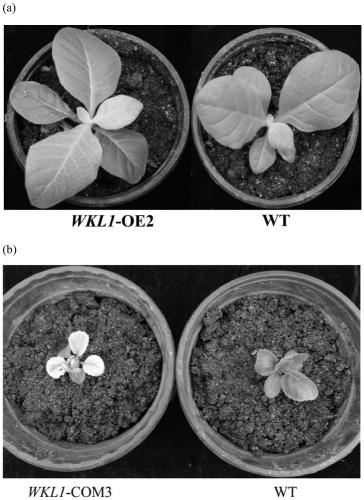Application of kale albino gene wkl1 in plant albinism
A technology of kale and cabbage, applied in the field of plant engineering, can solve the problems of unanalyzed, uncloned, and unstudied genetic laws
- Summary
- Abstract
- Description
- Claims
- Application Information
AI Technical Summary
Problems solved by technology
Method used
Image
Examples
Embodiment 1
[0020] The kale albino gene WKL1( W hit K ale L The acquisition of ocus 1):
[0021] 1. Genetic analysis of dominant mutant WKL1 phenotype
[0022] In this study, a genetic analysis of the mutant WKL1 phenotype was performed. F 1 , continue to backcross with the green headed cabbage haplotype to obtain BC 1 , after genetic analysis, in its BC 1 Medium white leaves: green leaves = 304: 299 ≈ 1: 1 (P>0.05), while in BC 1 f 2 White leaves:light white leaves:green leaves=27:52:20≈1:2:1(P>0.05). In summary, the white trait is incompletely dominant inheritance controlled by a single gene, named WKL1( W hit K ale L ocus 1). As an extremely rare dominant gene controlling white leaves, it is of great theoretical significance to understand how it participates in inhibiting the formation of chloroplasts.
[0023] 2. Map-based cloning of WKL1 gene
[0024] The method of BSA combined with RNA-seq, that is, BSR-seq (Liu et al., 2012), was used to initially map the WKL1 gene. ...
Embodiment 2
[0026] Application of kale albino gene WKL1 in plant albinism:
[0027] The WKL1 gene CDS sequence (shown in SEQ ID NO.1) was homologously recombined into the Hellsgate2 vector, and transformed into Agrobacterium, overexpressed with the 35S promoter, transformed into tobacco, and obtained 10 overexpressed T 1 Generation of positive seedlings, 4 of which produced white phenotype ( figure 1 Middle a), and the phenotype is consistent with the genotype. Homologous recombination of the WKL1 gene's own promoter and the full-length sequence of the WKL1 gene (shown in SEQ ID NO.1 and SEQ ID NO.3) into the Hellsgate8 vector, using the white kale WKL1 gene's own promoter and the full-length WKL1 gene functional complementary transfection into green cabbage, three positive plants were obtained, and the phenotype was whitening or severe yellowing of leaves ( figure 1 Middle b). The experimental results proved that the WKL1 gene, that is, CYP708A4, has the function of turning leaves whi...
PUM
 Login to View More
Login to View More Abstract
Description
Claims
Application Information
 Login to View More
Login to View More - R&D
- Intellectual Property
- Life Sciences
- Materials
- Tech Scout
- Unparalleled Data Quality
- Higher Quality Content
- 60% Fewer Hallucinations
Browse by: Latest US Patents, China's latest patents, Technical Efficacy Thesaurus, Application Domain, Technology Topic, Popular Technical Reports.
© 2025 PatSnap. All rights reserved.Legal|Privacy policy|Modern Slavery Act Transparency Statement|Sitemap|About US| Contact US: help@patsnap.com

